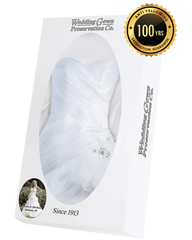The question of whether your wedding gown should be maintained in a vacuum-sealed container is one of the most frequently asked and debated topics. The word "Vacuum Seal" gives the idea of "freshness," "longevity," and "contaminant-free." While vacuum sealing is a great option for leftover foods and other tasty recipes, vacuum sealing without cleaning your wedding dress might become a ticket for disaster, turning your prized garment into a faded, yellowish memory of an otherwise lovely day.
We've gathered information from the world's most trusted and extensively scientifically tested fabric conservation and museum curators to help critically analyze why services that vacuum seal your wedding gown or trying the DIY part of vacuum sealing it yourself can become your worst nightmare.
Understanding Your Wedding Dress Fabrics And How They Age Over Time
The modern-day wedding gown has evolved into a stunning, extravagant, and intricate tangle of fabrics. Satin, silk, charmeuse, chiffon, organza, tulle, and lace are just a handful of the various fabrics used by fashion designers to create runway-worthy wedding gowns, each with its own set of characteristics.
The one thing they all have in common is that they are all organic. And as we know, all organic materials gradually degrade and decay with age. The bridal gown preservation technique acts as a way to slow down this process and even restore your wedding dresses.
Why Should You Clean Your Wedding Gown Before Storing It?
Did you know that microscopic elements and abrasion on the surface of your wedding gown can really break through the fiber materials of your gown over time? This is only one of the many reasons why you should get your wedding gown cleaned by professionals before storing it for the long term.
Another compelling reason to clean is invisible stains from your wedding day, such as makeup, body oils and sweat, perfume oils, and many other pollutants. These undetectable stains will tear down natural fibers over time, causing ugly yellowed wedding dresses and weak and brittle materials.
The Risks Of Storing A Wedding Dress In A Vacuum Bag
Although vacuum bags are more convenient, storing your wedding dress in one can cause significant damage
Moisture Is Trapped
According to the Smithsonian Institute, textile fibers must be preserved in an environment with appropriate air movement. Fabrics should not be enclosed in airtight plastic bags or containers to avoid long-term damage from moisture condensation.
What happens when moisture becomes trapped in an airtight storage container with your wedding gown? Dry rot. Dry rot is mostly concerned with mold damage and has little to do with rotting. Fabric storage in a humid environment is the most typical cause of dry rot.
The moisture trapped within the textiles of your gown feeds these spores that naturally circulate in the air, breaking down fragile threads. Unfortunately, dry rot and fabric degradation occur over time and are sometimes undetectable until severe deterioration has occurred.
Ruins The Natural Shape Of Your Wedding Gown
Fragile fabrics, such as the one used to make your bridal gown, like to wear thin along sharp folds. Instead of folding your bridal gown, roll it over soft fabrics to avoid harsh creases.
Getting your wedding dress cleaned and professionally preserved, paired with acid-free tissue paper, allows our skilled fabric handlers to wrap your gown using a roll-over technique that avoids fabric creases.
Expose It To Plastic Fumes
Another risk is storing your wedding gown in a vacuum bag. Plastic bags, particularly those not designed for long-term storage, degrade over time. This is especially true of the vacuum-sealed containers you could use to store seasonal items at home.
Due to molecular disintegration, these polymers emit fumes as they age. These plastics, as well as the fumes they emit, should never come into contact with your bridal gown, which is impossible with these vacuum-sealed DIY containers.
Alternatives To Vacuum Storage For Wedding Dresses
Preserving your wedding dress in a vacuum-sealed bag may sound like a great idea, but it is dangerous. The good news is that there are better and safer ways to store your dress and prevent white dress turned yellow. Now let us discuss these options.
1. Professional Wedding Dress Preservation Services
Preserving your wedding gown is one of the best ways of ensuring that your dress is well-maintained for use in the future. Every step is performed by expert cleaners specializing in wedding dress cleaning and preservation. It may be more expensive, but when comparing the dangers of storing it yourself and somehow ruining it, it’s worth it!
Here’s what to expect with professional preservation:
- Thorough Cleaning: Professional wedding dress cleaning is the first step in dress preservation because it removes stains, dirt, oil, and even faint traces of makeup or perfume. It is very important to get your dress cleaned because even the smallest of stains can rust and turn yellow if nothing is done to remove them.
- Repairs and Restoration: Some preservation services even extend the extra service of restoring wedding dresses. For example, they can fix loose beading, stitch up small tears, or restore delicate lace, making sure your dress looks as good as new.
- Acid-Free Packaging: The dress is washed and dried, wrapped in acid-free tissue paper, and stored in an acid-free box. Regular cleaning materials can cause discoloration and weaken the fabric over time. Using acid-free materials, your dress stays safe from yellowing or deteriorating, so it looks just as gorgeous as it looked on your wedding day.
2. Boxing Method
The boxing method is placing your dress in a breathable box made from acid-free materials. Here’s how it works:
Here’s what to expect with Boxing preservation:
- Folding with Acid-Free Tissue: The dress is gently folded with acid-free tissue paper placed between each fold to keep creases from setting in permanently. It also protects the fragile sections of your dress such as the bust area, shoulders, sleeves, and beautiful details to ensure nothing is ruined.
- Breathable Protection: Unlike those vacuum-sealed bags, the preservation box allows your dress to breathe! This helps control humidity and ensure that moisture does not accumulate and lead to mold or mildew formation over time.
- Long-Term Accessibility: This is one of the advantages of the preservation box; you can always check your dress anytime you feel like it. It can be refolded after several years so that creases do not develop, and this does not cause the wedding dress to turn yellow. It is the best way to ensure that the dress you are wearing is in the best shape at all times.
3. Bagging Method
The next good idea for the storage of wedding gowns is bagging. This method involves using a garment bag similar to the one used by museums to store heirloom textiles.
Here’s what to expect with the Bagging method of preservation:
- Hanging the Dress: Your dress is nicely hung on a padded hanger to prevent the fabric from stretching or wrapping around the hanger. For those heavier parts of the gown, twill tape or similar materials are used for added support to keep everything in its proper position.
- Breathable Garment Bag: Hanging the dress instead of folding it is the best way to avoid creasing, especially for dresses made of silk or satin. This method helps your gown stay smooth and beautiful all the time!
- Avoiding Creases: Hanging the dress instead of folding is a great way to prevent creases, especially for fabrics like silk or satin prone to wrinkling. This method helps your gown stay smooth and beautiful!
Ideal Storage Conditions For Your Wedding Dress
Now that you know why you shouldn't vacuum seal it, let's look at the ideal conditions for storing your wedding gown once it has been professionally washed and preserved. This is the common rule that all of our sources agree on: you should store your wedding gown in the same conditions that you would be comfortable in. Musty, humid basements and dramatic temperature changes in an attic should not be considered storage areas for your wedding dress.
The Effects of Humidity on Wedding Gown Storage
Wedding gown materials are hygroscopic, which means that as relative humidity levels rise and fall, they will naturally absorb and release water vapor contained in the air. Fibers swell, color transfer, and mold can grow at extremely high relative humidity levels.
Mold growth on clothes can occur in as little as 2-3 days in an area with humidity levels of 90% and above, according to the Canadian Conservation Institute, whereas humidity levels of 50% and lower completely eliminate mold formation when kept at a constant temperature of 77°F.
If you have air conditioning in your home, your gown should be OK during the hot, humid summer months. If not, giving your cleaned and preserved gown to a family member or friend for preservation in their humidity-controlled home may be the best option.
The Effects of Temperature on Wedding Gown Storage
High temperatures might also shorten the lifespan of your wedding gown. Chemically unstable materials, such as weighted silk, which is commonly used in wedding gowns, are especially vulnerable to disintegration at high temperatures.
Low temperatures benefit textiles in various ways, including minimizing chemical deterioration and the likelihood of insect infestation. High temperatures shorten the lifespan of your wedding gown.
In extreme cases, the rate of fabric deterioration at an optimum temperature of 32°F and 86°F is 20,000+ years and 250 years, respectively. This is a fantastic example of why you shouldn't store your wedding gown in the harsh circumstances found in attics.
The Effects of UV Light on Wedding Gown Storage
When it comes to long-term fabric storage, UV radiation is one of the worst offenders. UV light causes photooxidation, AKA phototendering, which causes materials to become weaker and embrittled over time.
Traditional colors can accelerate photooxidation, and silk materials are especially vulnerable to white dresses turning yellow when exposed to UV radiation over an extended period of time. Storing your wedding gown in a dark location rather than in direct sunlight can mean the difference between a gown lasting 2000 years and one that only lasts 100 years.
So, Where Should Your Cleaned And Preserved Wedding Gown Be Kept?
The ideal spot to keep your wedding gown in your home is underneath your bed. When you receive your wedding gown, it will be packaged in a display case that will be preserved within a UV-protected wedding dress storage box.
Keeping your wedding gown in this container under your bed will most likely be the best option. The basic explanation for this is that your bedroom is the one space in your house where you spend the most time and where you want to sleep the best.
Conclusion
While vacuum bags might seem space-efficient, they come with risks that can harm your wedding dress over time. Instead, go with professional preservation services like Trusted Wedding Gown Preservation, which uses acid-free materials and breathable storage to keep your gown safe.
With over a century of experience, we offer expert wedding dress cleaning with cutting-edge technology and pay close attention to preserving your dress’s unique details. Plus, we include free two-way shipping with insurance and complimentary cleaning for up to five wedding accessories.
We're dedicated to top-notch quality and ensuring your gown remains a cherished keepsake for generations. Ready to give your dress the care it deserves? Contact us today.












 200 Business Park Dr,
200 Business Park Dr,  (800) 830-4665
(800) 830-4665 info@trustedweddinggownpreservation.com
info@trustedweddinggownpreservation.com